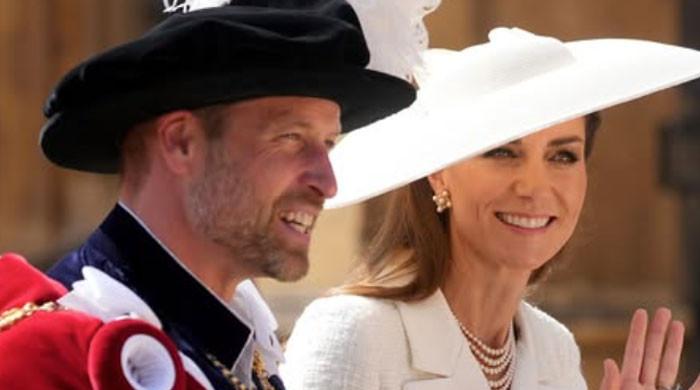The largest show is “An Adventure of Being,” whose title derives from Jean-Paul Sartre’s “Being and Nothingness,” according to curator Blair Murphy. It assembles the work of three artists based at least part time in New York City and one, Stephanie J. Williams, who lives in D.C. and Baltimore.
Williams offers one of the most playful pieces, a thicket of wooden stalks that culminate in tapered twists. Their sinuous shapes could represent many things, but each is painted white with two horizontal colored bands near where the natural wood tone yields to pigment. The effect is instantaneous recognition: gym socks! The forms don’t resemble human legs and feet, but the stripes render them somehow familiar.
A similar mix of outlandish and everyday characterizes the work of Jeremy Olson, the show’s only painter. His surrealistic pictures meld sci-fi settings with mid-20th-century modern architecture and populate these almost-believable locations with humanoids that might be background players from a “Star Wars” crowd scene.
Nicki Cherry conjures fleshy forms in such materials as stoneware, plaster and gypsum cement. A green frond protrudes from a circular wall piece, suggesting germination and growth. But nearby, a pink, vaguely human entity slumps on the floor, its posture redolent of collapse and death.
Hairpin-shaped neon tubes glow at the center of Vincent Cy Chen’s mixed-media sculptures, illuminating abstract assemblages that invoke tropical blooms but also bodily orifices. Complex and colorful, the Taiwan-born artist’s elegantly crafted pieces are strange but reassuringly symmetrical. Chen is concerned with humanity’s reluctance to acknowledge its place in nature, yet his own symbolic microcosms achieve an exquisite sense of balance.
In separate shows, Elliot Doughtie and Marissa Long conflate the human form with, respectively, industrial metal and a crystalline grotto. Doughtie’s “Tomato” is an assemblage of tools and machine parts, some shaped and others unaltered. Affixed to many of the metallic pieces are sprigs of epoxy whose rumpled shapes recall hair tufts or plant sprouts. These growths refer to the bodies of transgender people like the Baltimore artist, but they can also be seen as representing the growth of fruits (which a tomato technically is) and other organisms.
Visual representation of the human body is partial but more direct in Long’s “Blister Pearl,” a sculptural installation masked by diaphanous pink curtains that themselves evoke skin. At the gallery’s center is a trough studded with quartz crystals and flanked by stalagmites and the fragmentary forms of feet, hands and faces. Nearby, the MOCA Arlington resident artist placed simulated slugs, butterflies, slices of melon and flowers that grow from corporeal red sacs that appear to be moist and oozing.
Is the fragmentary body emerging from the grotto or receding into it? That doesn’t really matter. The essence, as in all three of these shows, is change. Things become other things, and the process is both morbid and beautiful.
Elliot Doughtie: Tomato and Marissa Long: Blister Pearl through Dec. 17 and An Adventure of Being through Feb. 11 at the Museum of Contemporary Art Arlington, 3550 Wilson Blvd., Arlington. mocaarlington.org. 703-248-6800.
The wild animals of South Africa are widely depicted, but rarely with Hannelie Coetzee’s expressionist flair. The Johannesburg artist’s fluid drawings appear at first to be little more than inkblots, but closer inspection reveals imagery that is remarkably well defined. The animals portrayed in Coetzee’s Morton Fine Arts show, “In Mid-Loping Gait,” are loosely rendered yet recognizable and expressive.
Coetzee calls her subjects “eco-queer creatures,” and her statement says their behavior “disproves the ‘naturalness’ of human heterosexuality.” (Some of the activity depicted in these drawings might be described as affectionate, but it is far from explicitly sexual.)
A multidisciplinary artist who often produces artworks for public spaces, Coetzee turned to drawing during the pandemic. She began traveling to Kruger National Park and other locations to portray hyenas, ostriches, zebras and other animals. She sometimes allowed wind to direct the wet black ink, or shifted the paper so that the pigment flowed in uncontrolled directions. Rather than disrupt the likenesses, these gambits give a sense of natural motion to kinetic groupings such as a band of galloping baboons. The black forms are incised with subtle white lines, occasionally highlighted by touches of color.
One aspect of the artist’s environmental consciousness is that she often uses reclaimed material. Much of the paper for these drawings was salvaged, and it includes pages from mining company ledger books. The irony is surely intentional: Coetzee’s sketches of nature symbolically undo the legacy of an industry that despoiled South Africa’s landscape.
Hannelie Coetzee: In Mid-Loping Gait Through Dec. 19 at Morton Fine Art, 52 O St. NW, No. 302. mortonfineart.com. 202-628-2787. Open by appointment.
The styles of the two artists featured in Cody Gallery’s “Intersections” don’t exactly intersect, but they do sympathize. David Carlson makes abstract pictures whose sinuous gestures are partly overpainted with white. Chee Keong Kung constructs wooden wall sculptures whose parts are mostly covered in white pigment or gesso. The bent metal rods that protrude from Kung’s pieces harmonize with Carlson’s painted black curves.
Carlson teaches at Marymount University in Arlington and curates shows at the nearby Fred Schnider Gallery. A Singapore native who trained as an architect, Kung is also based in Northern Virginia. He’s probably best known for futurist-like paintings in which straightedge forms seem to hurtle explosively at the viewer. There are linear segments in some of Carlson’s pictures, but they’re subsidiary to the spontaneous brushstrokes and the whitewashing that partly obscures both straight and swooping lines.
The centerpiece of “Intersections” is a Kung sculpture that fills the gallery’s back wall and is made of thin steel shafts that outline simple geometric shapes in space. Mounted slightly away from the wall, the piece complicates its simple forms by casting complex shadows. As in Carlson’s paintings, the area between the bottom and top surfaces is slight but intriguingly crowded.
David Carlson and Chee Keong Kung: Intersection Through Dec. 15 at Cody Gallery, Marymount University Ballston Center, 1000 N. Glebe Rd., Arlington. marymount.edu. 703-522-5600.







